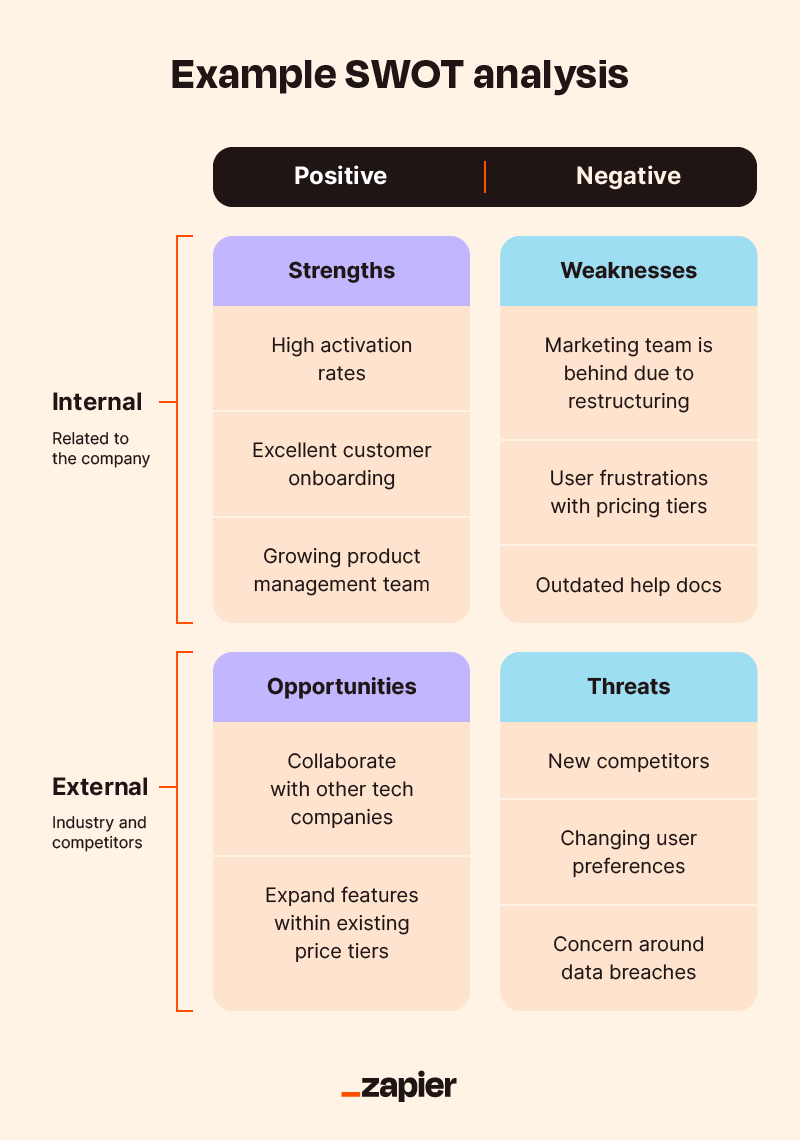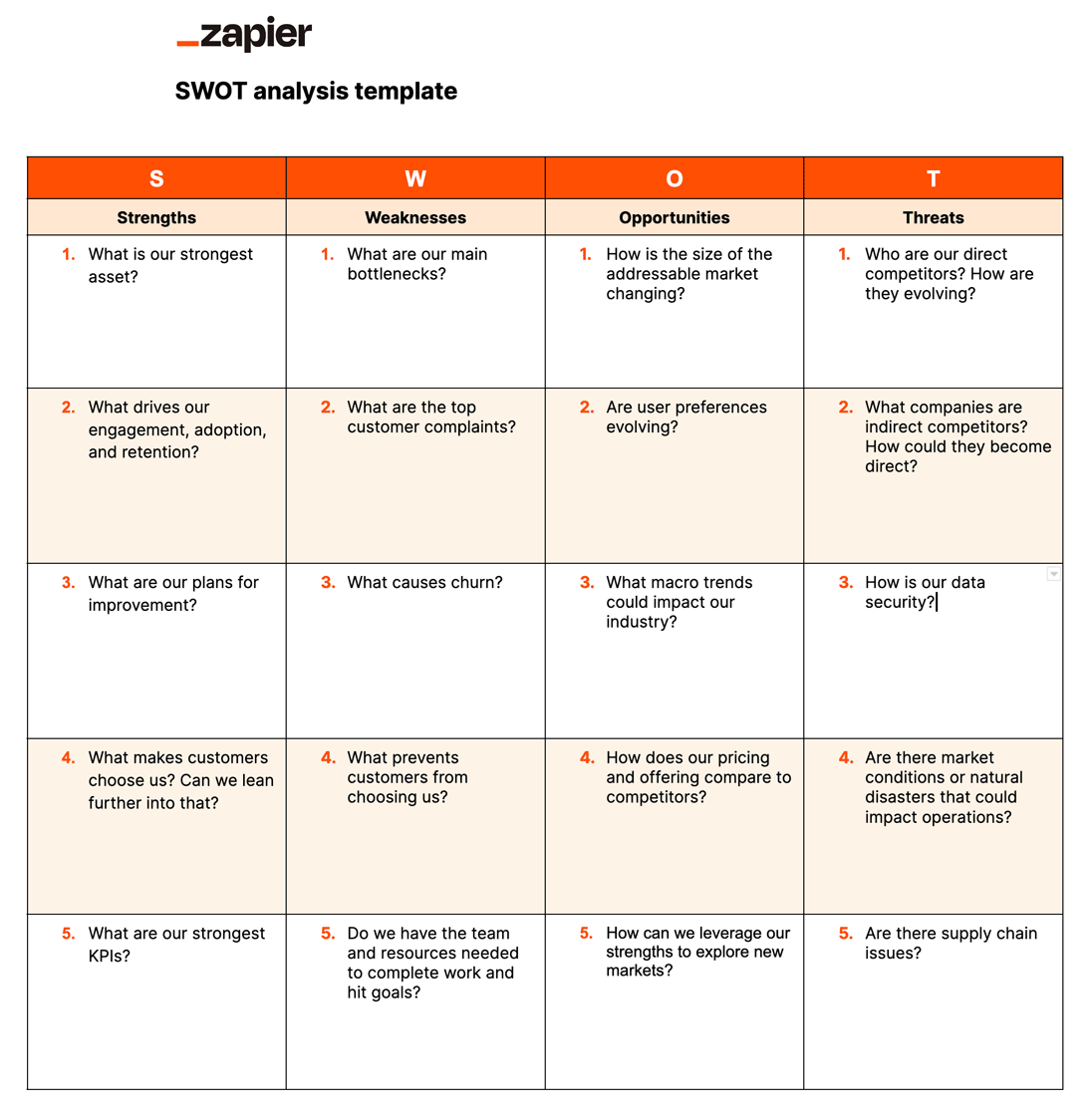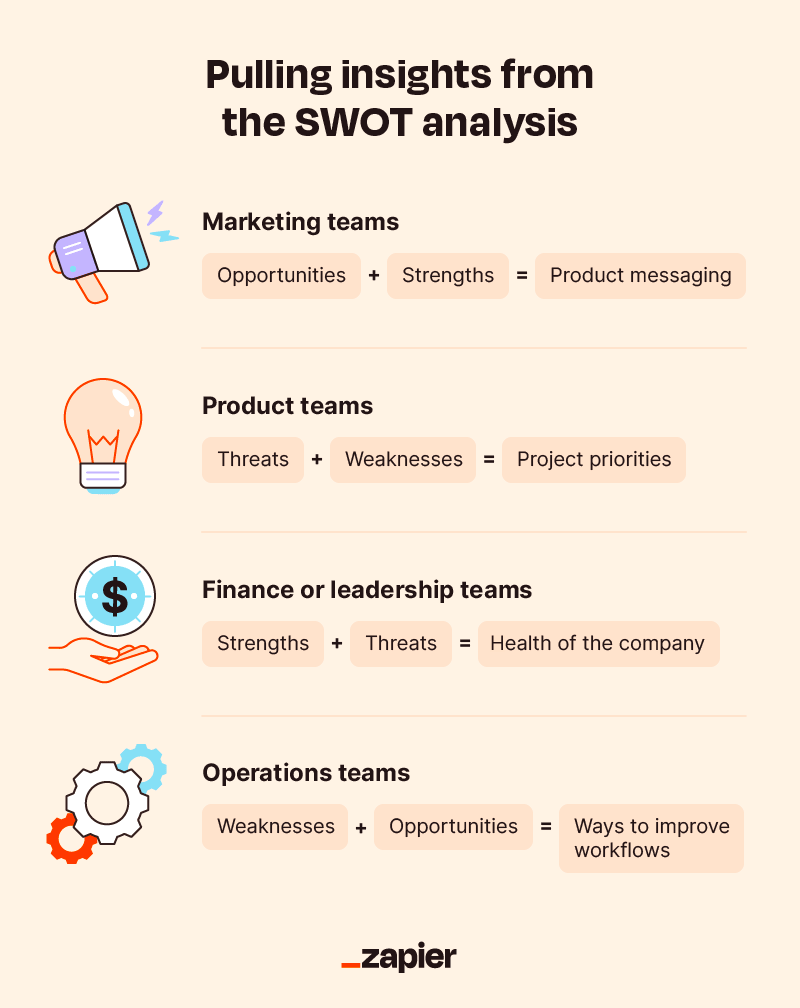Listen, I get it. The moment you hear “SWOT analysis,” you start to tune out, think about what’s for lunch today, and hope this discussion will be over soon. It makes sense, seeing as the only time most of us encounter SWOT is in some boring business textbook or on a vanilla LinkedIn post from a well-meaning manager named Craig.
While SWOT has a bland reputation, there’s a reason businesses have used it for decades. It’s time to reclaim the strategy as something less snooze-worthy.
Table of contents:
What is a SWOT analysis?
A SWOT (Strengths, Weaknesses, Opportunities, and Threats) analysis is a strategic planning technique that helps businesses evaluate internal and external forces to gauge their current business and plan for the future.
A SWOT analysis is all about context, considering the positive and negative forces that a company contends with internally and externally. SWOT stands for:
-
Strengths: Internal attributes and resources that provide an advantage
-
Weaknesses: Internal factors that put your business at a disadvantage
-
Opportunities: External elements you can capitalize on
-
Threats: External factors that could cause trouble for your business
Think of a SWOT analysis as a way to read the room so you can make informed decisions. If you’ve ever prepped for a family gathering by tallying which cousins will be in attendance and what world events your uncle might rattle on, you’ve done a SWOT analysis.
Like your daily horoscope, SWOT is a valuable tool, but it’s important to understand its limitations. Since the results are more subjective and qualitative, a SWOT analysis gives you a high-level overview but lacks detailed quantitative data. For comprehensive strategic planning, it should be paired with other analytical tools and research methods.

SWOT analysis template

Use this SWOT template as a starting point. It includes guiding questions and suggestions for extracting actionable insights from your analysis. To make the most of the template, you can either answer the suggested questions directly or fill in your own responses based on your unique situation.
How to do a SWOT analysis
Conducting a SWOT analysis isn’t rocket science, but there are some best practices to keep in mind. Let’s walk through the process step by step, using the fictional company Midsize Inc., a team collaboration app, as an example.
Step 1. Create a SWOT matrix (or copy the template)
The first step in conducting a SWOT analysis is to create your SWOT matrix. This visual layout will help you organize your thoughts and see connections between different elements.
Divide a piece of paper or whiteboard into four quadrants and label them appropriately: Strengths, Weaknesses, Opportunities, and Threats. Or, if you’re too busy to draw a giant plus sign, save yourself the trouble and copy the template if you scrolled straight past it.
Step 2. Define your objective
Think about why you’re doing this SWOT analysis in the first place. Are you:
Your objective will shape the entire analysis, so take a moment to really nail it down. Having a well-defined objective will help you focus your analysis and generate more relevant insights.
For Midsize, Inc., the objective of the SWOT analysis is to evaluate the company’s current position in the team collaboration app market and identify strategies for growth and improvement.
Step 3. Identify your strengths
Now it’s time to start filling in your SWOT matrix, beginning with your organization’s strengths. Strengths give your company an advantage over competitors.
Example questions to gauge strengths include:
-
What is our strongest asset?
-
What drives our engagement, adoption, and retention?
-
What are our plans for improvement?
-
What makes customers choose us? Can we lean further into that?
-
What are our strongest KPIs?
-
What skills does our team bring to the table?
Remember, strengths are internal factors—things you have control over. So while having a booming industry is great, it’s not a strength. Focus on what your organization brings to the table.
Midsize, Inc. makes data-informed product and marketing decisions that give them a few competitive advantages, including:
-
High activation rates thanks to excellent customer onboarding
-
A new CEO who wants to focus on user satisfaction and retention
-
A growing product management team
Step 4. Recognize your weaknesses
Next, identify your organization’s weaknesses. These are internal factors that cause your company to fall short of customer expectations or operational efficiency. Think of them as a list of excuses for why things aren’t going as well as they should.
Example questions to gauge weaknesses include:
-
What are our main bottlenecks?
-
What are the top customer complaints?
-
What causes churn?
-
What prevents customers from choosing us?
-
Do we have the team and resources needed to complete work and hit goals?
Like all companies, Midsize, Inc. has constraints that teams contend with. Their weaknesses include:
Step 5. Discover opportunities for growth
Opportunities are potential areas for growth, expansion, or improvement that exist in your market or industry. You don’t need to take advantage of all of them, but seeing your options laid out can help you prioritize big initiatives.
Here are some example questions to gauge opportunities:
-
How is the size of the addressable market changing?
-
Are user preferences evolving?
-
What macro trends could impact our industry?
-
How do our offerings and pricing compare to competitors?
-
How can we leverage our strengths to explore new markets?
In a fast-moving industry, Midsize, Inc. can capitalize on opportunities like the following to enhance its position in the team collaboration app market:
-
Exploring AI-powered productivity features
-
Collaborating with other tech companies or forming partnerships with industry leaders to open up new avenues for growth
-
Expanding features within existing pricing tiers that competitors charge more for
Step 6. Anticipate threats
Now it’s time to channel your inner pessimist and imagine all the ways your brilliant plans could go spectacularly wrong. Think of it as a fun exercise in controlled paranoia.
Threats are ways that the competition could encroach on your market share. These generally fall into three camps: new competitors, competitor advancements, and industry trends.
Example questions to gauge threats include:
-
Who are our direct competitors? How are they evolving?
-
What companies are indirect competitors? How could they become direct?
-
How is our data security?
-
Are there market conditions or natural disasters that could impact operations?
-
Are there supply chain issues?
The tech industry is constantly evolving. Some ways this could put Midsize, Inc. behind include:
-
New entrants into the team collaboration space may introduce innovative solutions.
-
Changing user preferences and demands requires continuous adaptation to stay relevant.
-
Growing concerns around data breaches call for additional data security measures.
After completing these steps, Midsize, Inc. would have a comprehensive SWOT analysis that provides a clear picture of its current position in the market and potential areas for strategic focus.
SWOT analysis examples
To further illustrate how SWOT analysis works in practice, let’s look at some hypothetical examples for well-known companies and organizations.
Discord SWOT analysis
Discord is a popular communication platform for online communities, particularly in the gaming space.
|
Strengths: • Large and highly engaged user base • Strong brand affinity with millennial and Gen Z gamers • Easy-to-use freemium model with many features and integrations |
Weaknesses: • Limited marketing reach and brand awareness outside of gaming • Lack of control over user-generated content • Limited monetization options |
|
Opportunities: • Expansion into verticals beyond gaming, like education and professional networking • Partnering with popular game developers and eSports organizations • Developing features to support the creator economy |
Threats: • Competition from messaging apps like Slack and Microsoft Teams • Data privacy concerns and changing regulations • Reliance on third-party platforms and services |
Spotify SWOT analysis
Spotify is a digital music streaming service that gives users access to millions of songs, podcasts, audiobooks, and the occasional Sabrina Carpenter track, whether you asked for it or not.
|
Strengths: • Large, diverse music library • Sophisticated playlist algorithms and music discovery features • Strong brand recognition in the streaming industry |
Weaknesses: • Ongoing disputes with artists over royalty payments • Reliance on licensing agreements with record labels • Limited differentiation from competitors in terms of core features |
|
Opportunities: • Expansion of original content production and exclusive deals • Development of new features for artists and listeners • Potential for growth in emerging markets |
Threats: • Intense competition from Apple Music, Amazon Music, and other tech giants • Pressure from artists and labels for higher royalty payments • Risk of losing key artists or content to exclusive deals with competitors |
Costco SWOT analysis
Costco is a membership-based wholesale retailer where you can buy in bulk, fill up on free samples, and, if you’re lucky, witness a fight over the last $5 rotisserie chicken.
|
Strengths: • Strong brand loyalty and high customer retention rates • Bulk purchasing power leading to competitive pricing • High-quality, curated product selection |
Weaknesses: • Limited product variety compared to traditional retailers • Reliance on membership fees for profitability • Limited online presence compared to competitors |
|
Opportunities: • Expansion of private-label Kirkland Signature products • Growth in international markets • Development of more eCommerce and delivery options |
Threats: • Increasing competition from online retailers like Amazon • Pressure to adopt more sustainable practices and packaging • Shifting consumer preferences toward smaller, more frequent purchases |
Crocs SWOT analysis
Crocs, the footwear company known for its distinctive foam clogs, is beloved by many for its comfort and despised by others for its aesthetic.
|
Strengths: • Iconic and recognizable product design • Lightweight, comfortable, and durable footwear • High profit margins on products |
Weaknesses: • Polarizing style that may limit appeal • Seasonal sales fluctuations • Reliance on a single iconic product line |
|
Opportunities: • Growth in international markets with localized designs • More collaborations with fashion brands and designers • Increased focus on sustainability and eco-friendly materials |
Threats: • Increased competition in the casual footwear market • Economic downturns impacting discretionary consumer spending • Intellectual property challenges with copycat products |
When you should (and shouldn’t) use SWOT
A SWOT analysis helps you understand your business and how it exists in context. That’s powerful stuff, but it doesn’t mean you should lean on this method in every scenario.
When to use SWOT analysis
-
You need a high-level view. You can apply SWOT to your entire company or focus on a niche, market, or department. Whichever level you choose, the analysis gives you a broad picture of conditions.
-
You have research to include. Your analysis will stand on firmer ground with quantitative or qualitative insights.
-
You need to decide on positioning (or prepare to pivot). Because SWOT looks internally and externally, it’s helpful when you need to make big guiding decisions. Combining your competitors’ shortcomings with your strengths is also an excellent product positioning opportunity.
When to skip the SWOT
-
You’re the only one working on it. The point is to identify positives and negatives you aren’t already aware of. You won’t get the full effect if you create in a vacuum. Instead, get input from a diverse set of stakeholders across departments.
-
You want to understand one issue deeply. SWOT goes wide. It can tip you off to significant trends, but if you want to make a really specific decision, you’ll need to go on a side quest.
-
You don’t have a clear reason to do it. There needs to be something to prompt the SWOT, or else you may get lost in too many details. If there’s a new competitor, your business is going in a new direction, or you’re trying to understand why growth is stagnant, a SWOT makes sense. Otherwise, considering every contributing element could get overwhelming. You could use SWOT as part of an annual checkup, but it would still be helpful to have a few specific questions, goals, or concerns in mind.
Making decisions based on your SWOT
Simply filling out a SWOT analysis template might give you clarity on a problem you’ve been trying to solve. But applying a SWOT analysis might not look the same for every team.
For example:
-
The marketing team could combine opportunities and strengths to find new messaging.
-
The product management team could combine threats and weaknesses to prioritize additions or improvements.
-
The finance team or leadership might weigh strengths versus threats to gauge the company’s health.
-
The operations team can combine weaknesses and opportunities to improve workflows.
No matter which segments pertain to your team, try to summarize a few takeaways at the end of the analysis. For our example company, Midsize, Inc., a takeaway could be refactoring pricing tiers to meet user needs and capitalize on industry opportunities or adding more automation to their workflows to help with marketing bottlenecks.

SWOT analysis: FAQ
Still think a SWOT analysis is nothing more than an annoying business school requirement? Here are answers to some common SWOT questions and dilemmas.
What are the benefits of a SWOT analysis?
A SWOT analysis:
-
Breaks down large problems into a manageable report
-
Uses internal and external factors to make well-informed decisions
-
Incorporates multiple data sources
-
Helps you set realistic goals
-
Identifies competitive advantages and market opportunities
-
Can be applied to multiple business facets
What are the 4 components of SWOT Analysis?
The four components of a SWOT analysis are strengths, weaknesses, opportunities, and threats.
-
Strengths cover internal attributes, capabilities, and resources that provide a competitive advantage.
-
Weaknesses represent internal limitations or areas in need of improvement.
-
Opportunities involve external factors and emerging trends that could create favorable conditions for growth and success.
-
Threats are external factors that could prevent progress or pose risks.
What are the biggest SWOT analysis mistakes?
Here are some of the biggest SWOT analysis mistakes, in the event you miraculously got by in college without having to do one:
-
Lack of objectivity: Ignoring research and data in favor of your assumptions or “gut feeling” negates the whole point of the exercise. Be honest about weaknesses, and let the data lead you.
-
Relying only on SWOT: A SWOT analysis is a great tool, but it can’t be the only thing you use to make decisions. Incorporate it into a broader strategic planning process with additions like a PEST analysis or buyer personas.
-
Not validating findings: Don’t run with data until you’ve verified it. Discussions, feedback, and data analysis can help you ensure accuracy and relevance.
-
Not taking action: If you type up this report and then never open the file again, you’re doing it wrong. Identify the most critical findings from your report, prioritize them, and make an action plan.
A SWOT analysis gives you actionable takeaways for your business. But unlike business school, you don’t have to do the whole process manually. Automate your competitor analysis to speed things up and keep a constant pulse on your market position.
Related reading:
This article was originally published in April 2022 by Steph Knapp. The most recent update was in August 2024 by Allisa Boulette.